

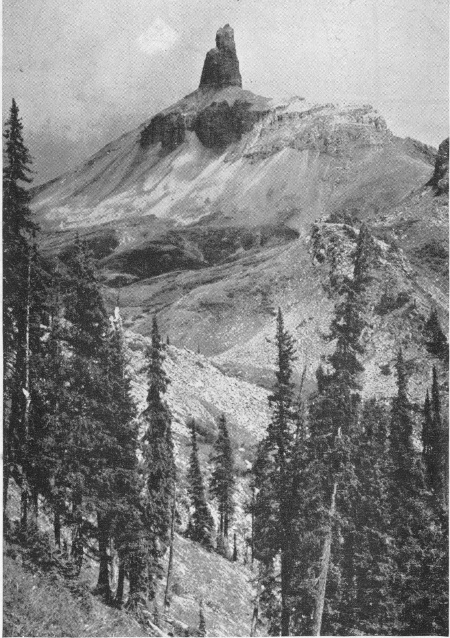
F-376802
LIZARD HEAD PEAK
UNITED STATES DEPARTMENT OF AGRICULTURE
FOREST SERVICE
ROCKY MOUNTAIN REGION
THE MONTEZUMA NATIONAL FOREST was established by proclamation of President Theodore Roosevelt on June 15, 1905. Its gross area is 837,228 acres, of which 737,440 acres are Government land.
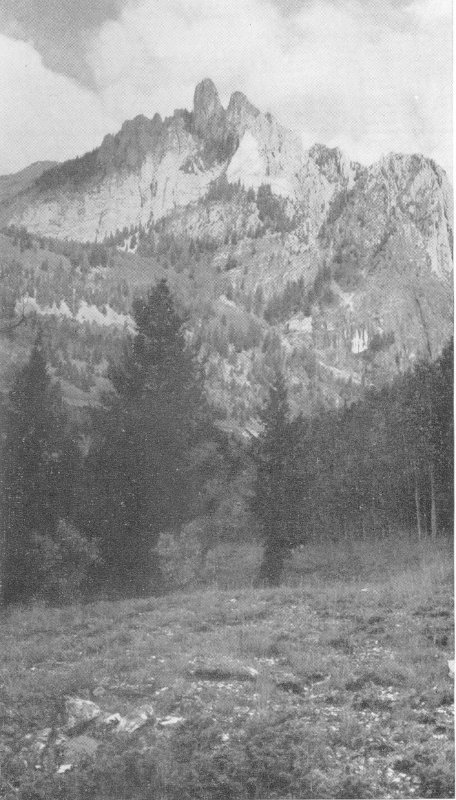
F-376865
OPHIR NEEDLES
The topography of the forest varies from the extremely rugged San Miguel Range in the north and the rough 3 but slightly lower La Plata Range on the east, to the high mesas of the southwestern part. The Dolores River flows southwest through the eastern part of the forest. Near the town of Dolores the river makes an abrupt turn to the north, and the west boundary of the forest follows to a greater or less degree the Dolores River Valley. Throughout the forest innumerable streams and canyons lead down from the San Miguel and La Plata Ranges and the Dolores Plateau.
The San Miguel Range extends westward through the north end of the forest. Lizard Head Peak (13,156 feet), Sunshine Mountain, Lone Cone, Wilson, and Dolores Peaks, and Mount Wilson (14,250 feet) are outstanding topographical features.
Montezuma was the ninth king of Mexico and a powerful general of the Aztec tribes. When Hernando Cortez conquered Mexico in the early part of the sixteenth century, Montezuma was the dominant war chief of the Western Hemisphere and was held in fear by other tribes. He tried, however, to avoid war with the Spaniards and welcomed them to the capitol. Cortez, having thus obtained an advantage, held Montezuma and the city captive. In the succeeding battles, Montezuma was killed by his own people.
The name has retained historically romantic significance and occurs frequently throughout the Southwest. It is appropriate for this forest where most of the names and many of the customs are of Spanish origin.
Spanish traders and explorers made frequent trips into southern Colorado during the eighteenth century. Those of record were led by Capt. Juan Marie de Rivera, in 1765, and Padre Francisco Escalante, in 1776. Each party followed approximately the same route from Santa Fe to the San Juan Basin, westward to the Mancos River, thence northward across the forest through the Dolores and San Miguel Valleys to the vicinity of the present town of Placerville. From this point they crossed the Dallas Divide to the Uncompahgre and Gunnison Valleys. De Rivera’s route beyond that point is unrecorded. Escalante continued through 4 Colorado, Utah, Arizona, and New Mexico to Santa Fe.

F-376867
T-I-M-B-E-R!
During these expeditions, Spanish names were given to many of the geographical and topographical features and were retained throughout the forest. Farther north, they were replaced by English names.
In 1831, the St. Louis Fur Company employed a party under command of W. G. Walton to trap along the headwaters of the San Juan River. The party spent the summer of 1833 in the valley of the Rio Dolores and at Trout Lake. Parties under the command of Lieutenant Howard in 1861 and Colonel Nash in 1866 were also in the Dolores Valley. Prospectors soon followed, and claims were located in the vicinity of Rico in 1869. Ranchers came in very soon after the prospectors, and the mining and cattle industries were principally responsible for settlement and development within and adjacent to the forest.
Mancos, where the forest headquarters are located, 5 and the southern part of the forest may be reached over U S 160 from Durango and Alamosa, Colo., to the east or Cortez and Monticello, Utah, from the west. U S 550, a highly scenic route from Montrose, Ouray, and Silverton, joins U S 160 at Durango.

F-376864
TROUT LAKE WITH VERMILION PEAK AND SAN JUAN MOUNTAINS IN BACKGROUND
During the summer, busses operate over these highways between Grand Junction and the Mesa Verde National Park, which lies a short distance south of the Montezuma National Forest.
The best approach from the south is U S 666, from Shiprock, N. Mex., to Cortez, on U S 160. From points near that junction two State highways extend northward through the forest. State Highway 145 passes through Dolores, Rico, Telluride, Placerville, and Norwood, important towns within or near the forest, to junctions with State Highways 62 and 90. State Highway 147 is a more direct route between Dolores and Norwood, and State Highway 184 connects Dolores and Mancos.
The Rio Grande Southern Railroad was completed in 6 1891 and led to the rapid development of the forest area. This railroad traverses approximately the same route as State Highway 145 between Dolores and Placerville, and the principal towns of the forest may be reached by rail from Ridgeway or Durango, where connections are made with the Denver and Rio Grande Western Railroad.
There are 158 national forests within the United States, including two in Alaska and one in Puerto Rico. They contain approximately 175,000,000 acres of public land and are administered by the Forest Service, United States Department of Agriculture. The Montezuma is one of 14 in Colorado.
To grow a timber crop and to protect the forest and vegetative cover as a precautionary measure against erosion on the watersheds, are important and necessary. To this end the national forests were established with the positive injunction that all their resources were to 7 be protected, developed, and used in perpetuity for the benefit of all citizens. Therefore, conservative use of all forest resources, with adequate protection to insure a continual supply, has been the primary consideration in their management.
The forests of the Montezuma have high watershed value and a forest cover is very important, because the dominant soil types are silt and clay loam which erode readily. If these soils are not held in place, much material is carried away by the streams. In the aggregate, this has a considerable effect on the Colorado River and the water it furnishes for irrigation.
The headwaters of the principal streams of this region rise on the forested watersheds of the Montezuma. These watersheds are covered with deep snows each winter, and the forest cover retards the melting snow and provides a more uniform distribution of the run-off. Watershed protection is, therefore, an essential and important factor in the administration of the forest.
Irrigation water for Thompsons Park, the Montezuma and Paradox Valleys, and the Norwood-Redvale country is provided by streams which rise in the Montezuma Forest. The towns of Rico and Telluride obtain their water supply from the forest. In addition to the use of water for irrigation and domestic purposes, a number of water-power sites have been developed on the forest. A large volume of water flows into the Colorado River, and these waters are impounded by Boulder Dam and used for power and irrigation in the general development of that project.
The Montezuma National Forest has a stand of about 2,072,000,000 board feet of timber. About 57 percent of this is Engelmann spruce, 23 percent is ponderosa pine, and 19 percent is a mixture of alpine and cork-bark fir. There are also small quantities of Douglas fir and piñon pine.
During the last 5-year period there has been an average yearly cut of 12,000,000 board feet of lumber on the forest. Most of this was sawed at McPhee, where the largest sawmill in Colorado is located. It has a capacity of 80,000 board feet each working day. In previous years, it has sawed considerable timber cut from privately-owned land, but is now dependent largely upon timber from the forest. The spruce timber, of which 8 there is a large amount on the Montezuma, is especially well suited for pulpwood.
Timber is grown and cut in accordance with approved forestry methods. Mature trees to be removed are marked in advance of cutting by trained foresters. Trees which are not mature are left to be cut in later years. They respond to the influence of more light, soil moisture, and nutriment with greatly increased growth and also seed the open places.
Raising livestock is a large and important industry in and adjoining the forest. Stock is wintered on the nearby ranches and depends for summer pasture on the forest ranges. Some 20,000 cattle and 66,000 sheep, owned by 285 stockmen, are grazed on the forest each summer.

F-376871
MILL POND AT M’PHEE
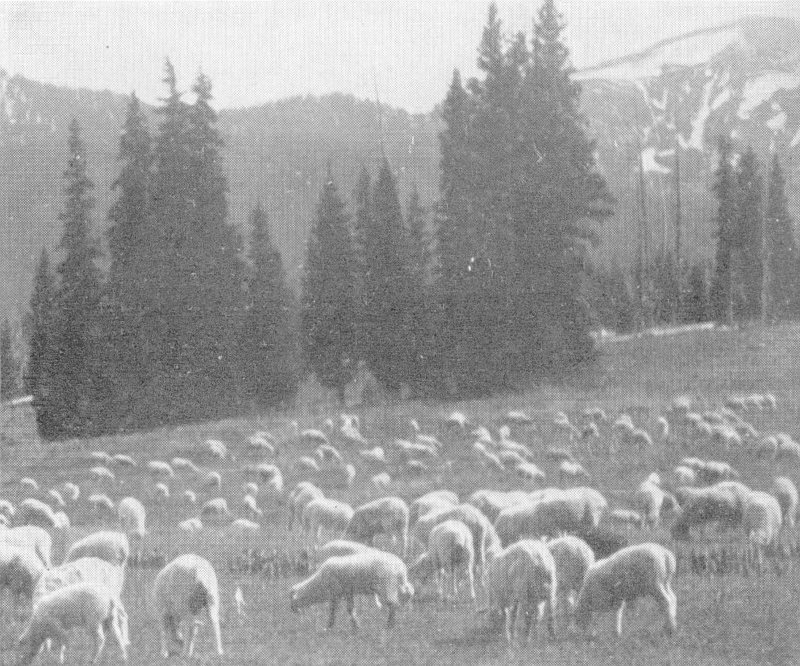
F-80528
SHEEP GRAZING IN A GRASS PARK AREA OF THE MONTEZUMA

F-364895
IMPROVED PUBLIC CAMP AND PICNIC GROUNDS ARE AVAILABLE AT MANY
ATTRACTIVE POINTS ON NATIONAL FORESTS AND ARE EQUIPPED WITH
FIREPLACES, TABLES, AND SANITARY FACILITIES.
The handling of the summer range is a large undertaking. Distribution and management of livestock are carefully regulated to prevent damage to the forest growth and to conserve the forage resources. A cover of grasses and weeds must be retained to prevent erosion. Forest officers constantly study the ranges and work with stockmen in planning management of grazing and construction of improvements needed for the control of stock.
In the allotment of range, previous use of the range and the raising of sufficient forage to feed stock during the winter are determining factors. The permanent ranch owner is given preference, which helps to stabilize the industry.
Mining was and still is an important industry of the forest region. The mines of Telluride and Ophir, in San Miguel County, have been heavy producers. Telluride, with its famous Liberty Bell, Smuggler Union, and Tomboy mines, is still one of the producing camps of southwestern Colorado. Figures furnished by the 10 United States Bureau of Mines place the total ore production of these camps during the period 1875 to 1937, inclusive, at $119,349,969. The output for 1930 to 1937, inclusive, was $2,539,940.
Rico, the principal mining camp of Dolores County, reached the peak of production in 1893, when ores to the value of $2,696,371 were mined. The total output of mines in that vicinity since 1879 is placed at $20,574,557.
Mining claims may be located in the national forests wherever ores of sufficient value to justify development are found. Legitimate mining is encouraged by the Forest Service.
The recreation areas of the forest are extensively used by local residents and tourists for picnicking, camping, fishing, hunting, and riding. Improved public camp and picnic grounds are available at many attractive points and are equipped with fireplaces, tables, and sanitary facilities. Medium-price resort accommodations are available near and within the forest from which trips may be made to points of scenic and historical interest. Saddle horses and pack horses are obtainable for those who wish to ride or camp in the back country and see the forest from the many trails that lead into the areas not accessible by roads.
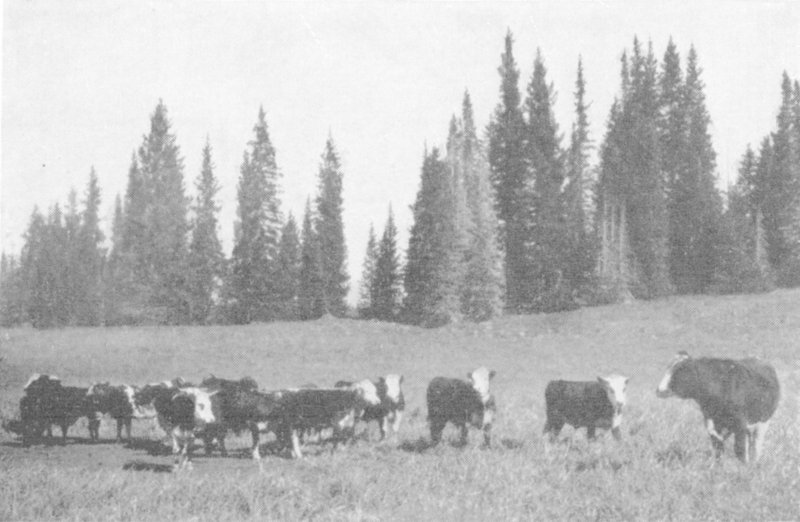
F-24903A
USE OF FORAGE RESOURCE HELPS TO STABILIZE THE LIVESTOCK INDUSTRY
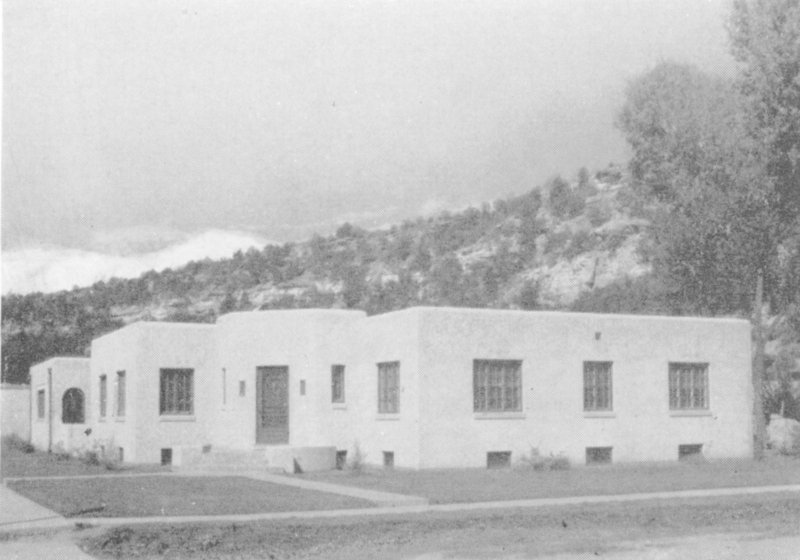
F-376869
DOLORES RANGER STATION
The Wilson Mountain Wild Area extends west from Lizard Head and Blackface Mountains to Flat Top and Dolores Peaks and contains about 27,347 acres. Sunshine, Wilson, and Gladstone Mountains and Wilson Peak are included, and the area affords the utmost in scenery and mountain climbing. Nearly half of it is barren land above timberline. About 5,000 acres are wet meadows or alpine grasslands. The remainder is covered with timber, chiefly Engelmann spruce and alpine fir. Grazing of domestic stock, improvements necessary for fire protection, and development of water-storage projects may be permitted, but there will be no summer homes, no resorts or commercial enterprises, no scenic highways, and no commercial timber cutting.

F-376868
LONE CONE PEAK
An area of 2,800 acres, especially adapted to scientific and educational use and known as the Narraguinnep Canyon Natural Area, has been designated in the canyon of that name which drains into the Dolores River, about 24 miles west of the town of Dolores. Access to this canyon is difficult and no timber cutting or grazing of domestic stock is permitted. Under these restrictions, it will be possible to preserve in its virgin condition a typical southwestern Colorado canyon type of ponderosa and piñon pine, juniper, oak, serviceberry, and other shrubs and plants.
In 1937, forest officers estimated that there were 470 elk, 4,000 mule deer, 400 black or brown bears, and a few mountain sheep on the forest. Deer, mountain sheep, and bears are not increasing but are holding about even numbers, while elk are increasing. The forest could support more of these game animals, and efforts are being made to build up the big game resources. Game birds are not plentiful, but grouse and ptarmigan may be seen. Ducks nest on the numerous reservoirs and small lakes on the forest.

F-376866
LOADING LOGS
Excellent trout fishing is found in the streams and lakes. The Dolores River affords 50 miles of good angling and its west fork 30 miles more. East and West Mancos Rivers, Bear, Bilk, and Beaver Creeks, and tributaries of the Dolores River are good fishing streams. Trout and Woods Lakes contain large fish and are popular places for recreation.
Forest officers or State game wardens will gladly give information about the routes to follow, the location of improved campgrounds, the better places to hunt or fish, and where to obtain horses to go beyond the end of the motor roads.
Sportsmen who enter the forests to hunt or fish should obtain the State license required by law; and all are asked to exercise care with fire.
The area now within the Montezuma National Forest suffered repeatedly from fires before the forest was established. Since being put under administration, the fire loss has been reduced. Nevertheless, the loss has been considerable—4,037 acres of timber, grass, and brushland within the forest having been burned over in 28 years, or an average of about 144 acres annually. Seventy-nine percent of this was burned in 6 bad fire 14 years. In 6 favorable years, the loss was less than 1 acre annually. Without prompt action of local citizens and forest officers, however, the average burned and the damage sustained would unquestionably have been very much greater.
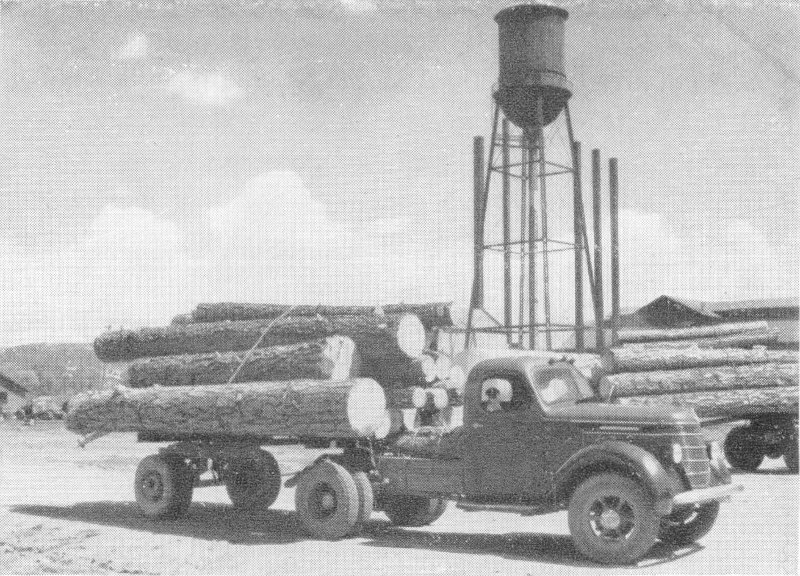
F-376870
HAULING LOGS FROM THE NATIONAL FOREST
Fire is the most destructive enemy of the forests. A lighted match, cigarette, or cigar carelessly tossed aside, or a campfire left burning may result in a disastrous forest fire and the destruction of valuable forest cover.
About 51 percent of the fires that occur in the Rocky Mountain Region are man-caused and are preventable. Visitors to the forests are urged to exercise the greatest care with fire, and to follow carefully the SIX RULES FOR PREVENTION OF FOREST FIRES printed elsewhere in this folder.
The Montezuma National Forest is divided into five ranger districts, each of which is administered by a forest ranger, working under the direction of the forest supervisor. The rangers are always ready to furnish information to visitors and assist them in every way possible. The headquarters of the supervisor and the rangers are listed below:
| Forest Supervisor | U. S. Forest Service, Mancos, Colo. |
| Forest Ranger | Mancos District, Mancos, Colo. |
| Forest Ranger | Dolores District, Dolores, Colo. |
| Forest Ranger | Glade District, Dolores, Colo. |
| Forest Ranger | Rico District, Rico, Colo. |
| Forest Ranger | Norwood District, Norwood, Colo. |
| Forest Ranger | Timber Sales, McPhee, Colo. |
PINES—Three species.—They have their needles gathered together at the base in bundles of from two to five. The cones are woody and pendent.
Limber pine (Pinus flexilis).—Stout, dark-green needles, 1½ to 3 inches long, in bundles of five. Cones 3 to 10 inches long, with seeds about ⅓-inch in length. Cone scales smooth. Bark light gray, except on old trunks, which are blackish brown and furrowed.
Ponderosa pine (Pinus ponderosa).—This tree was formerly known as western yellow pine. Needles 5 to 11 inches long, dark green, usually three in a cluster, but often in twos and in tufts at the ends of the branches. Cones 3 to 6 inches long, oval-shaped. Cone scales armed with spines. When young, the bark is dark, and the tree is known as “black jack” or “bull pine.” When older, the bark is reddish brown and occurs in thick, scaly ridges.
Piñon or piñon pine (Pinus edulis).—Piñon is a short, scrubby tree, often growing in mixture with juniper, and is confined to the foothills. Needles usually in bundles of two, rarely three, ¾ to 1½ inches long. Cones 1½ inches long and almost as broad, containing large seeds, which are the piñon nuts of commerce.
SPRUCES.—Two species. Needles scattered over the twigs singly. Needles are sharp-pointed, four-sided, leaving twigs rough like a grater when they fall off. Cones pendent, with parchmentlike scales, falling off the tree whole.
Engelmann spruce (Picea engelmannii).—The new-growth twigs are covered with soft, short hairs. Needles less rigid and less sharply pointed than those of blue spruce; green, dark blue green, or pale steel blue. Cones about 2 inches long. Bark is dark reddish brown and separates in the form of small, rounded scales. Main trunk, in contrast to blue spruce, is smooth and clean.
Blue spruce (Picea pungens).—The new-growth twigs are not covered with hair. Needles stiff, with sharp points, varying in color from silvery blue to green. Cones about 3 inches long. Bark of mature trunks gray and deeply furrowed. Main trunk always has numerous short twigs pushing out between branches.
FIRS.—Two species. Needles blunt, flat, and soft to touch, without any stem where they join branches. Needles leave flat, round scars when they fall off, in contrast to short stubs left by spruce needles on twigs. Cones, unlike those of other conifers, are erect. In the fall the cone scales drop off, leaving only a spike on the branch. Buds blunt and pitchy. Blisters containing pitch or balsam are scattered over the smoother bark.
Alpine fir (Abies lasiocarpa).—Blunt flat needles, about 1 to 1¾ inches long, soft to the touch and fragrant. Needles tend to turn upward. Dark-purple cones, 2¼ to 4 inches long. Bark smooth, grayish white, except on older part of the trunk, where it is broken into ridges. Tree has a sharp, spirelike crown. Grows at high altitudes, usually with Engelmann spruce.
Corkbark fir (Abies arizonica).—The trunk, crown, cones, and needles of the corkbark and alpine fir are so alike in general appearance that the two cannot be readily distinguished by these features. The cone scales of the corkbark fir are of a different form than those of the alpine, and the bracts borne on the backs of the scales also differ materially. The ashy-gray, soft, corky trunk bark alone readily distinguishes this tree from the alpine fir.
DOUGLAS FIR (Pseudotsuga taxifolia).—Though similar in name, this species is not a true fir. Flat leaves, ¾ to 1½ inches long, with a short stem that joins them to the branches. Cones with three-pronged bracts extending beyond the cone scales. Cone scales persistent, the cones falling off the tree whole. Buds are sharp-pointed, shiny, smooth, red brown.
JUNIPERS or CEDARS.—Three species. Fruit reduced to small, bluish berries, needles reduced to tiny green scales on the twigs, though sometimes spreading and about ½ inch long, making twigs very prickly to the touch.
Rocky Mountain red cedar (Juniperus scopulorum).—Berries ¼ to ⅓ inch in diameter, bright blue, usually with 2 seeds. Berries mature in 2 years. Bark scaly, twigs slender and graceful, heartwood red.
One-seed juniper (Juniperus monosperma).—Berries small, mostly less than ¼ inch in diameter, usually contain only one seed, maturing in 1 year. They are covered with a bluish bloom which may be rubbed off exposing the true reddish or coppery color. Twigs stiff and stout. Heartwood brown.
Utah juniper (Juniperus utahensis).—Berries ¼ to ⅓ inch long. Bark ashy gray, about ¼ inch thick, broken into long thin scales. Wood light brown, with nearly white sapwood. Berries are reddish brown, have one or rarely two seeds, mature in 2 years. A small bushy tree, rarely over 20 feet high.
Aspen (Populus tremuloides).—Commonly called quaking aspen. Flat, broadly oval leaves, up to 4½ inches across, that tremble characteristically in a breeze. Bark whitish or very pale green, smooth, with black scars where branches have dropped off. Trees rarely more than 60 feet high.
Narrowleaf cottonwood (Populus angustifolia).—Usually a tall tree, 40 to 60 feet high. Bark light yellow-green, divided near the base of old trees into flat ridges; smooth and thinner above. Leaves ¼ to 1 inch wide and 2 or 3 inches long, very similar to willow leaves. Usually found along streams at lower elevations.
Mountain alder (Alnus tenuifolia).—Found along and overhanging streams, usually in clumps, several trees growing from the same root, frequently 4 to 6 inches in diameter and 15 to 25 feet high. Leaves double-toothed, 2 to 4 inches long and 1½ to 2½ inches wide. Mature seed-bearing fruit noticeable in winter.
Willows (Salix, sp.).—The common shrub of creek bottoms. Usually narrow, sharp-pointed leaves. Some willows attain a diameter of 4 inches and a height of 15 to 25 feet. Buds are covered by a single scale.
Western choke cherry (Prunus demissa).—Clustered flowers and fruit; alternate leaves, sharply pointed. Bark, leaves, and seed bitter. Fruit black. Tree, or more often a shrub, up to 15 feet in height.
Scrub oak (Quercus sp.).—Usually a shrub, rarely over 15 feet high. Alternate leaves, smaller at the base than at the ends, with deep lobes, frequently drying on the tree and remaining over winter. Fruit, a short pointed acorn. Forms dense thickets at lower elevations. Often valuable for fence posts.
Pacific serviceberry (Amelanchier florida).—Leaves silvery, sharply toothed above the middle and alternate on branches. Trees, or more often shrubs, 6 to 15 feet high. Flowers white and in clusters. Five hard seeds in each berry. Berries edible, nearly black, when ripe.
Rocky Mountain maple (Acer glabrum).—Usually a shrub, but frequently 20 to 30 feet high. Paired opposite buds, 3 to 5 lobed leaves, dark reddish-brown bark, and paired, winged seed. Leaves 3 to 5 inches in diameter, opposite each other.
Boxelder (Acer negundo).—Compound leaves with 3 to 5, rarely 7, leaflets, pale-gray or light-brown bark, and paired, winged seeds, which ripen in the autumn. Compound leaves opposite each other.
Hawthorn (Crataegus sp.).—Usually a shrub; dark scaly bark; leaves simple and alternate; fruit small, fleshy, and in clusters. Armed with sharp spines.
1. PURIFICATION.—Mountain streams will not purify themselves in a few hundred feet. Boil or chlorinate all suspected water.
2. GARBAGE.—Burn or bury all garbage, papers, tin cans, and old clothes.
3. EXCRETIONS.—Bury a foot deep all human excretions, at least 200 feet from streams, lakes, or springs.
4. WASHINGS.—Do not wash soiled clothing, utensils, or bodies in streams, lakes, or springs. Use a container and throw dirty water on the ground away from the water supply.
5. TOILETS.—Use public toilets where available. They are properly located. Toilets should be at least 200 feet from streams and not in gulches.
6. OBSERVE LAWS.—Observe the rules and endeavor to have others do the same. National and State laws impose heavy penalties for health-law violations. Report all violations or insanitary conditions (including dead animals) to the nearest health officer or Forest Service officer.
1. MATCHES.—Be sure that your match is out. Break it in two before you throw it away.
2. TOBACCO.—Be sure that pipe ashes and cigar or cigarette stubs are dead before throwing them away. Never throw them into brush, leaves, or needles. Do not smoke while traveling through the woods.
3. MAKING CAMP.—Before building a fire scrape away all inflammable material from a spot 5 feet in diameter. Dig a hole in the center and in it build your campfire. Keep your fire small. Never build it against trees or logs or near brush. Where available, use grates and stoves which have been provided.
4. BREAKING CAMP.—Never break camp until your fire is out—DEAD OUT. Use water where available.
5. BRUSH BURNING.—Never burn slash or brush in windy weather or while there is the slightest danger that the fire will get away.
6. HOW TO PUT OUT A CAMPFIRE.—Stir the coals while soaking them with water. Turn small sticks and drench both sides. Wet ground around the fire. Be sure that the last spark is dead.

F-376563
MYSTIC FALLS
BE SURE YOUR MATCH IS OUT
BREAK IT IN TWO
BEFORE YOU THROW IT AWAY
U. S. GOVERNMENT PRINTING OFFICE

| SECTIONAL DETAIL MAPS | ||
|---|---|---|
| NORTHWEST | NORTH | NORTHEAST |
| SOUTHWEST | SOUTH | SOUTHEAST |